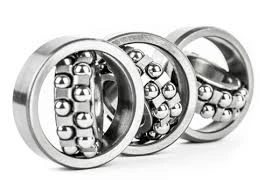
Nov . 12, 2024 11:38 Back to list
miniature tapered roller bearing
Understanding Miniature Tapered Roller Bearings
In the realm of engineering and mechanical design, the importance of precision components cannot be overstated. One such component that stands out for its versatility and efficiency is the miniature tapered roller bearing. Although small in size, these bearings are critical for various applications across multiple industries, ranging from automotive to aerospace, as well as in household appliances and robotics.
What are Miniature Tapered Roller Bearings?
Miniature tapered roller bearings are a specific type of rolling element bearing that utilizes tapered rollers to manage axial and radial loads. The term miniature refers to their small dimensions, typically with an outer diameter of less than 50 mm. These bearings consist of an inner ring, an outer ring, a cage, and tapered rollers that sit within the special raceways of the inner and outer rings. The taper allows the rollers to distribute loads more effectively, enabling the bearing to accommodate both axial and radial stresses simultaneously.
Design Features and Advantages
The design of miniature tapered roller bearings provides several advantages
1. Load Capacity Due to their tapered shape, these bearings can support high loads and withstand shock loads, making them ideal for dynamic applications. 2. Space Efficiency Their compact design allows for significant weight and space savings in applications where every millimeter matters.
3. Versatility These bearings can be found in a wide variety of applications including motors, robotic arms, wheel assemblies, and precision instruments. Their adaptability makes them a preferred choice in multi-functional equipment.
4. Reduced Friction The interaction of the tapered rollers with the raceways minimizes friction, leading to quieter operations and improved efficiency.
miniature tapered roller bearing

Applications Across Industries
The applications of miniature tapered roller bearings are extensive and varied. In the automotive industry, they are used in gearboxes, differential gears, and wheel hubs, helping to ensure smooth operation and enhancing vehicle performance. In the field of aerospace, these bearings can be found in landing gear assemblies and in-flight control systems where reliability and precision are paramount.
Furthermore, miniature tapered roller bearings are crucial components in high-speed machinery. For instance, they are often employed in spindles of CNC machines, ensuring that high-precision work can be executed consistently. In consumer electronics, such as hard disk drives, these bearings help maintain stability and performance under varying operational conditions.
Manufacturing and Material Considerations
The manufacturing of miniature tapered roller bearings involves precise engineering and advanced machining processes. Typically crafted from high-quality steel or ceramic materials, these bearings undergo rigorous quality control and testing to ensure optimal performance. The choice of materials plays a significant role not only in load-bearing capacity but also in resistance to wear, corrosion, and thermal variations.
Advancements in manufacturing technology, including the development of surface treatments, have further enhanced the performance of these bearings. Coatings that reduce friction and improve resistance to degradation are becoming standard practice, particularly in high-performance applications.
Conclusion
In conclusion, miniature tapered roller bearings are integral components that facilitate the operational efficiency and reliability of various machinery and equipment across multiple industries. Their unique design allows them to handle complex loading conditions while maintaining a compact form factor, making them an indispensable choice for engineers and designers alike. As technology continues to advance, the role of these bearings is likely to expand, paving the way for even more innovative applications and improvements in performance. Whether it's in high-speed machines or intricate electronic devices, miniature tapered roller bearings are a testament to the ingenuity and necessity of precision engineering in our modern world.
Latest news
-
Spherical Roller Bearings Applications: Heavy Duty, Self-Aligning
NewsAug.30,2025
-
Premium Deep Groove Ball Bearings | High Speed & Reliability
NewsAug.29,2025
-
Durable Scaffolding Clamps - Secure & Reliable Tube Connectors
NewsAug.28,2025
-
Common Failures in Thrust Ball Bearings and Solutions
NewsAug.22,2025
-
How Tapered Roller Bearings Can Take Shock Loads
NewsAug.22,2025
-
Angular Bearings in High-Precision Spindles
NewsAug.22,2025
